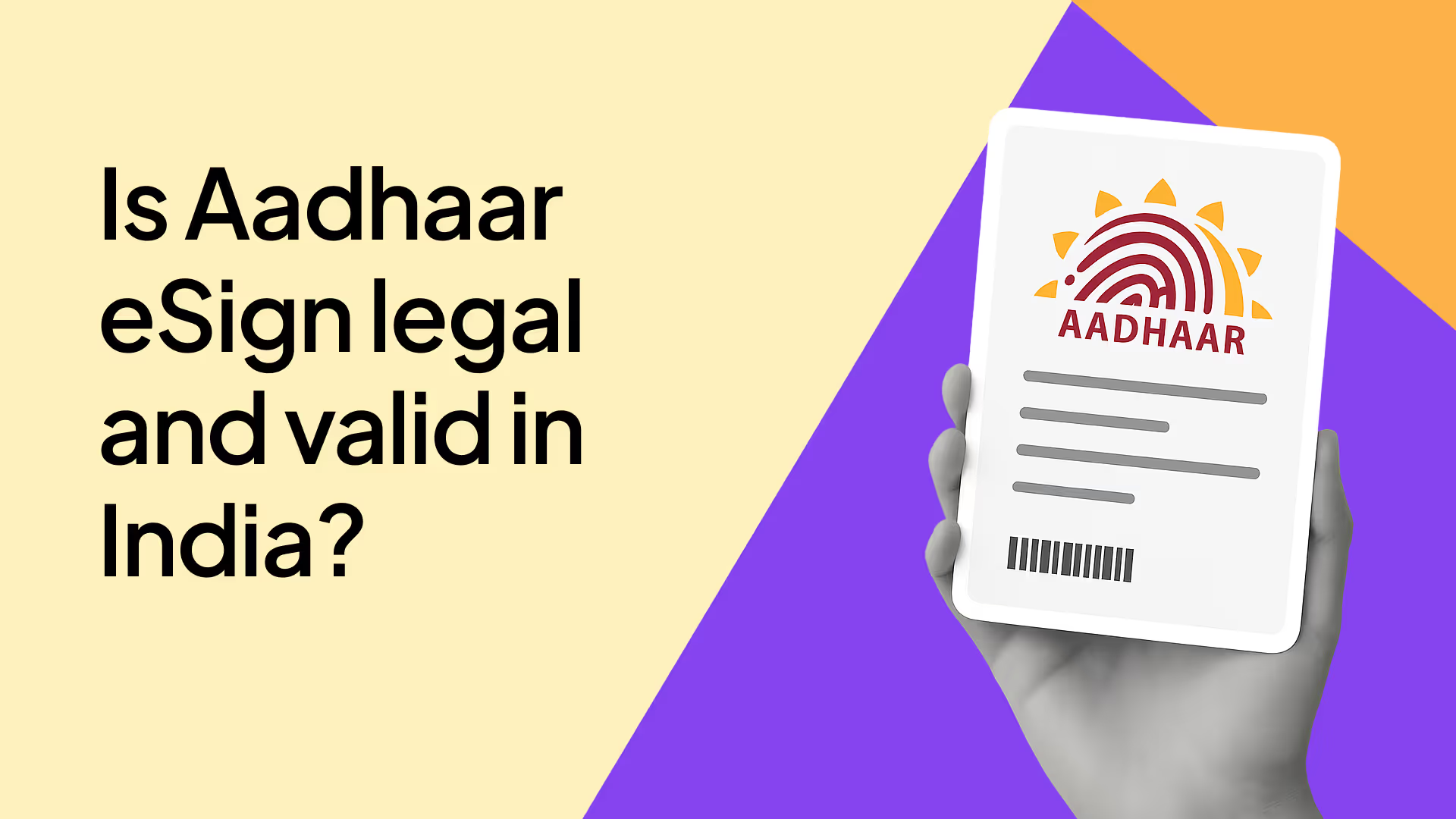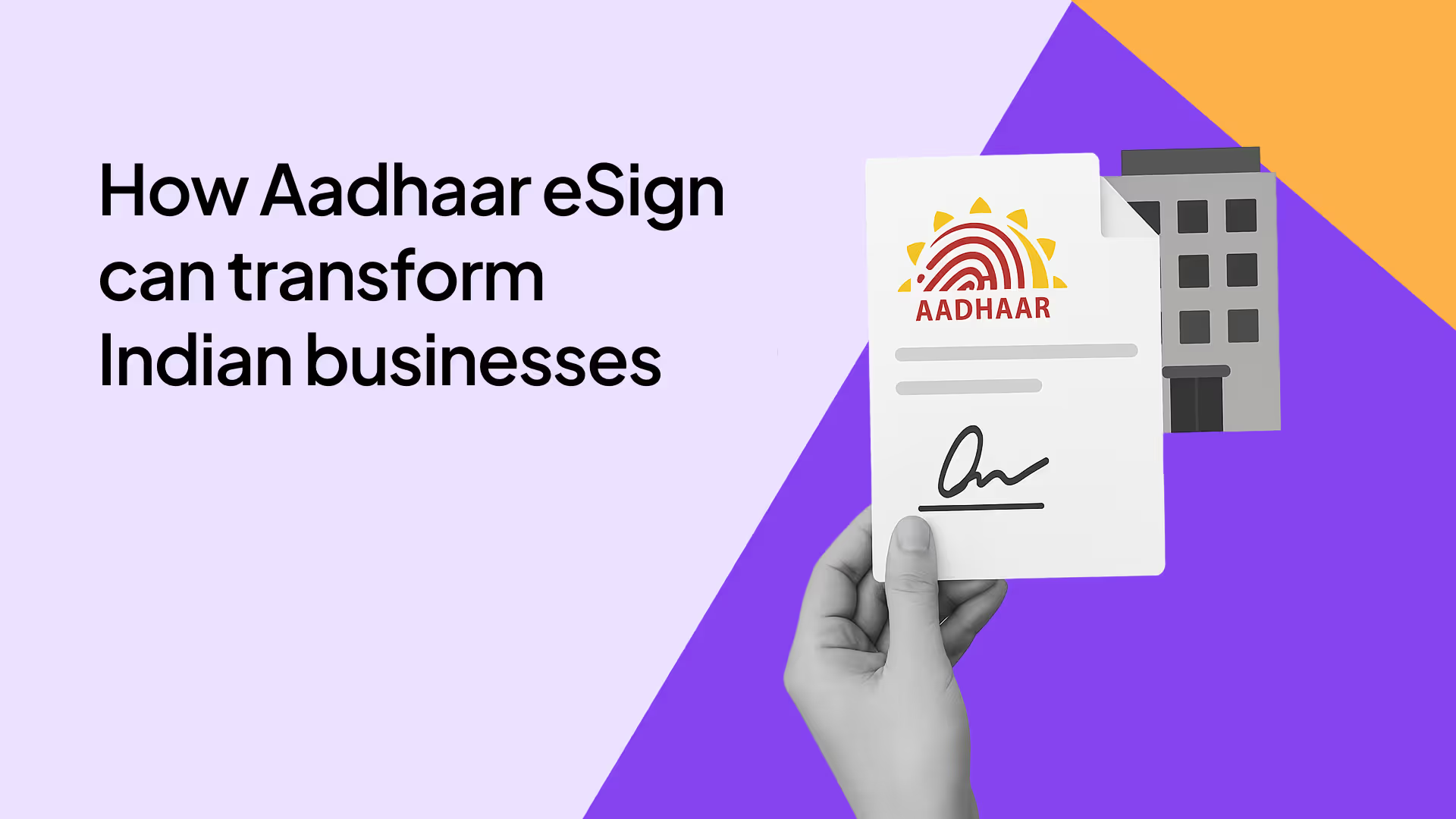What is Aadhaar eSign?
Aadhaar eSign is a method of digitally signing a document using Aadhaar Card. Documents affixed with Aadhaar eSigns have legal and evidentiary value equivalent to that of hand-written signatures. With Aadhaar eSign, any Aadhaar holder can sign documents electronically without the need of physical paperwork.
While Aadhaar eSign is far more scalable than traditional digital signatures, it makes use of the same underlying technology to provide similar security benefits. Aadhaar eSign makes use of a secure cryptographic key pair system to generate compliant and secure electronic signatures.
How to use Aadhaar eSign to digitally sign a document?
The Aadhaar eSign process is a very simple, easy process for the end signer. Here is how you can eSign a document using Aadhaar eSign:
Step 1: Signer receives a signing link on phone, email or on an application they are using (e.g Net banking app, loan app etc.). Signer then views the document and gives consent to Aadhaar eSign
Step 2: Signer is redirected to eSign Service Provider Page where he enters Aadhaar number and authenticates OTP/Biometric/IRIS
Step 3: Upon successful authentication - Aadhaar eSign is affixed on the document.
Step 4: Signer receives eSigned document via email or SMS
How to validate Aadhaar based eSign in India?
Let’s say you have received an Aadhaar eSigned document from someone else. Now you want to validate the authenticity of the Aadhaar eSign. How do you do this?
Step 1: You can open a verifier tool like Leegality’s eSign verifier
Step 2: Upload or drag and drop your signed document in a pdf format to the verifier
Step 3: Click on “Initiate Verification” button
If your signature on the Aadhaar eSigned document is legit, you will see the message “Signature verified” in the box below. If not, you will see the message “Document not digitally signed”
What documents can you eSign using Aadhaar?
You can affix Aadhaar eSign on all types of documents EXCEPT the following 4 types of documents
- Negotiable instruments (other than a cheque, a demand promissory note or Bill of Exchange issued in favour of or endorsed by an entity regulated by the RBI, NHB, SEBI, IRDAI and PFRDA))
- Powers-of-attorney except those that empower an entity regulated by the RBI, NHB, SEBI, IRDAI and PFRDA to act on behalf of (and in the name of) the person executing them
- Documents that create trusts
- Wills and other testamentary depositions
For more information - do check out our Aadhaar eSign documents blog
What are the Key Benefits of using Aadhaar based eSign?
Aadhaar eSign has an edge over other eSign methods in terms of its simplicity, security & widespread acceptance. Here are few key advantages of using Aadhaar eSign to digitally sign a document:
- Legally Secure - In addition to IT Act, Aadhaar eSign also carries presumptuous of validity under the Evidence Act making it legally secure and enforceable in India
- Accessibility - Aadhaar eSign is accessible on phones making it widely acceptable and easily adoptable mode of eSigning process in India
- Convenience - To eSign any document using Aadhaar, all you need is a mobile phone & your Aadhaar number
- Integration with Digital Services - Aadhaar eSign can be seamlessly integrated into various online platforms, making it an ideal choice for businesses and service providers that need a reliable and legally recognized digital signing solution.
Is Aadhaar eSign Legal in India?
Yes, Aadhaar eSign is legal in India. In 2015, the government legally introduced Aadhaar eSign, incorporating it into the Second Schedule of the Information Technology Act vide Gazette Notification No. 2015 Jan – GSR 61(E)). The government did so, under its powers in Section 3A of the Information Technology Act.
Aadhaar eSign is also in daily use by thousands of regulated entities, government entities, enterprise companies and businesses in India.
For a deeper dive into the legal nature of Aadhaar eSign check out our Aadhaar eSign legal blog
Is Aadhar based eSign legally enforceable?
An Aadhaar eSign is very easy to enforce because it performs these 3 functions very well at a technological level:
Authentication: Assists in identifying the identity of signer by referencing the details stored in electronic signature certificates.
Integrity: Guarantees that whenever document is opened using a PDF reader, the system will notify the user if any changes were made to the document.
Non - Repudiation: evidence needed to show that the signers Aadhaar number and phone, used for e-authentication process was not with was user, which is highly improbable.
Need more information, check out our Aadhaar eSign enforceability explainer.
How does Aadhaar based eSign works in backend?
Step 1 - When signer gives consent to sign a document on front-end interface by an ASP, the ASP also performs the hashing function on the document to create its hash result
Step 2 - Once the signer clicks on the signing link and is redirected to the portal of an ESP where e-authentication happens, they enter the Aadhaar number. The ESP then asks UIDAI to conduct an eKYC with the signer. UIDAI then sends and OTP to the number linked with signer’s Aadhaar number. After the signer enters this OTP, UIDAI authenticates the OTP to check if the authentication was a success or a failure.
Step 3 - Upon successful authentication of the signer’s identity, the ESP creates the Secure Key Pair for the signer. The Private Key of the signer is stored and secured in a Hardware Security Module maintained by the ESP.
Step 4 - After the key pair generation, the ESP sends the public key and the eKYC information (which it received from UIDAI) to the Certifying Authority in the format prescribed by the CCA under the eSign API specifications. Upon receiving these particulars, the CA issues the Electronic Signature Certificate for the Signer and passes it onto the ESP.
Step 5 - The ESP encrypts the input document hash (passed on by the ASP in Step 1) using the private key to create a scrambled hash result. The ESP then passes the Electronic Signature Certificate and the scrambled hash result to the ASP, which then facilitates affixture of the eSign on to the document.

Why is Aadhaar eSign good for your Business?
Aadhaar eSign is a game changer for businesses. Because of its simplicity and accessibility, Aadhaar eSign opens up the world of digital documentation for businesses. There are tons of advantages of using Aadhaar eSign in your business transactions:
- Low TAT - Aadhaar eSign eliminated the need for paperwork, thus the process of getting documents signed from multiple parties that used to take days in the physical paperwork can now be done in minutes.
- Remote Accessibility - Aadhaar eSign gives you the power to sign documents from anywhere and at any time thus providing a lot of flexibility in signing a document.
- Security - Digitally signed documents are safer from tampering, any physical damage. Also, its difficult to make errors in the document as everything happens digitally.
- Cost - effective - Aadhaar eSign eliminated the business cost of storage of documents, man hour wastage at branch to get the documents signed as well as cost of ink & paper.
Need more information, check out our Aadhaar eSign for your business blog



